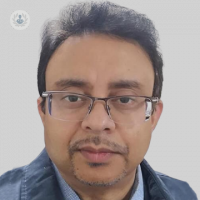An introduction to paediatric neurology
Escrito por:Paediatric neurology is a specialised branch of medicine dedicated to diagnosing and treating neurological disorders in children. This field focuses on conditions affecting the nervous system, which includes the brain, spinal cord, and peripheral nerves. Paediatric neurologists are uniquely trained to address neurological issues in infants, children, and adolescents, whose nervous systems are still in developmental stages. This specialty encompasses a broad spectrum of disorders, from common ailments like headaches to complex conditions such as epilepsy and cerebral palsy.
Renowned consultant paediatric neurologist Dr Rajib Samanta provides a comprehensive guide to what paediatric neurology involves.

The role and importance of paediatric neurologists
Children's brains and nervous systems differ significantly from those of adults, requiring unique diagnostic and treatment approaches. Paediatric neurologists play a crucial role in early detection and intervention, which are vital for preventing or mitigating long-term impacts on a child's motor skills, cognitive abilities, and social interactions. These specialists collaborate closely with other healthcare providers to deliver comprehensive, individualised care tailored to each child's specific needs. In addition to medical treatment, paediatric neurologists provide essential education and support to families.
They guide parents on managing symptoms, exploring treatment options, and addressing the challenges that may arise as their child grows. This holistic approach ensures that the child’s physical, emotional, and social well-being are all considered.
Common neurological disorders in children
Several neurological disorders frequently affect children, each with unique symptoms and treatment strategies. Epilepsy, characterised by recurrent seizures, requires personalised treatment plans involving medications, lifestyle adjustments, and occasionally surgery. The goal is to control seizures and enhance the child's quality of life. Cerebral palsy, resulting from brain injury or abnormal development before, during, or shortly after birth, impacts movement and muscle coordination. Treatment is multidisciplinary, often including physical and occupational therapy and sometimes surgical interventions to improve mobility and independence. Attention deficit hyperactivity disorder (ADHD) manifests as inattention, hyperactivity, and impulsiveness, affecting academic performance and social interactions. Treatment typically involves behavioural therapy, medications, and educational support to help children manage symptoms and thrive in their daily activities.
Diagnosis of neurological disorders
Diagnosing neurological disorders in children involves a comprehensive approach, beginning with a detailed medical history and physical examination. Paediatric neurologists gather information about the child's development, family history, and specific symptoms to identify patterns indicative of neurological conditions. Imaging studies like MRI and CT scans provide detailed pictures of the brain and spinal cord, revealing abnormalities such as tumours, structural defects, or damage.
Electroencephalograms (EEGs) measure brain electrical activity to detect seizures or other abnormal patterns. In some cases, genetic testing is employed to identify inherited conditions, allowing for precise diagnoses and tailored treatment plans.
Treatment options
Treatment for paediatric neurological disorders is highly individualised. Medications are used to manage symptoms, such as anti-epileptic drugs for seizures or stimulants for ADHD, with the choice of medication depending on the child’s age, overall health, and condition severity. Therapies play a crucial role in treatment plans. Physical therapy helps improve motor skills, while occupational therapy enhances daily living skills.
Speech therapy addresses communication challenges. These therapies are often integrated into a comprehensive care plan to support the child's overall development. Surgical interventions are necessary in some cases, such as severe epilepsy unresponsive to medication or structural abnormalities needing correction. Paediatric neurologists work closely with neurosurgeons to ensure optimal outcomes.
Family support and future directions
Families play a critical role in supporting children with neurological disorders. Educating themselves about the child's condition, creating a supportive home environment, and advocating for appropriate educational and medical resources are essential. Support groups and community resources also provide valuable assistance and emotional support. The future of paediatric neurology is promising, with ongoing research and technological advancements driving improvements in diagnosis and treatment. Emerging therapies, such as gene therapy and neurostimulation, hold potential for treating previously untreatable conditions. Collaboration across medical disciplines enhances understanding and treatment of paediatric neurological disorders, while increased public awareness and advocacy efforts improve access to care and outcomes for children worldwide.
If you would like to book a consultation for your child with Dr Samanta, do not hesitate to do so by visiting his Top Doctors profile today.


